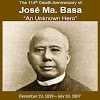During the weekend, I was at the administration center of the Mount Kanla-on Natural Park in Barangay Biak-na-Bato in La Castellana, upon the invitation of the Multi-Sectoral Alliance for Development–Negros to be a resource person for training on protected area management.
The training participants were selected officials of the five barangays covering MKNP in La Castellana town, specifically Sag-ang, Mansalanao, Cabagna-an, Biak-na-Bato and Masulog. The event was part of the current initiative of MUAD in promoting biodiversity conservation and sustainable agriculturein MKNP.
The Foundation for the Philippine Environment provides funding support to this project that also aims to integrate MKNP management plan to the local development plan of the five barangays.
I designed the activity to be an interactive one. Instead of using computer and projector for my presentation, I employed the approach of what we call in trainings and workshops as “chalk-talk,” which means the resource person writes or illustrates in the board the salient points of the topic while on the process of discussion.
After some preliminaries of getting to know, I asked, “What is Mt. Kanla-on to you?” The question was meant to elicit feedbacks on how familiar the training participants are about the protected area, since all of them reside at the periphery of the MKNP.
It was really interesting, because the participants’ responses synchronized with that of the outline I prepared for deliberation. The first answer was Mt. Kanla-on is an active volcano, followed by a landmark. Others mentioned that MKNP is a natural resource and it is where the different species of wildlife exist.
One participant said that MKNP is a major source of water and livelihood, and an important settlement of the different barangays of La Castellana and Murcia towns, and the cities of Bago, La Carlota, Canla-on and San Carlos.
While Mt. Kanla-on has long been proclaimed as a national park, and later on as a protected area, under the National Integrated Protected Areas System of the Philippines, it has never been spared from encroachment. Thousands of settlers are now enjoying permanent residency in the area and most of them are engaged in agricultural development.
However, unlike in the Northern Negros Natural Park where intrusion includes the construction of rich individuals’ vacation houses and resorts, in MKNP, majority of occupants are marginal farmers, who depend on it for livelihood.
At this point in time, when natural hazards and risks are major concerns in our lives given the advent of the changing climatic pattern of the world, it is very necessary to revisit the settlement issue in the MKNP, because, as one training participant echoed, Mt. Kanla-on is an active volcano, too.
It should be noted that the Philippines Institute of Volcanology and Seismology has declared the four-kilometer radius of the active crater as permanent danger zone, and supposedly shall be closed from human activities, especially settlement.
The fertility of soil surrounding the volcano has attracted thousands of farmers to convert a large track of MKNP’s land into agriculture, especially vegetable production, and along with it, they also constructed permanent settlement in these areas. Unfortunately, a big part of this development is within the four-kilometer permanent danger zone of Kanla-on Volcano, particularly in La Castellana, Canla-on and San Carlos, and some of these areas are even susceptible to landslides and flooding.
There is now a serious question on what we intend to do in this kind of situation. It is important to note that local governments have the legal and moral responsibility and accountability to ensure the protection of their constituents from natural hazards and risks.
God forbid, but shall we wait for a major volcanic eruption to be sorry about it? (To be continued)*









0 Comments